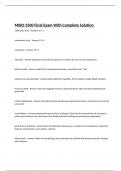Exam (elaborations)
MIBO 3500 Final Exam With Complete Solution
- Course
- Institution
millimeter (mm) - Answer 10^-3 micrometer (um) - Answer 10^-6 nanometer - Answer 10^-9 Microbes - Answer Organisms and acellular agents too small to be seen by the unaided eye Robert Hooke - Answer made first compound microscope, coined the term "cell" Antoine van Leeuwenhoek - Answe...
[Show more]



